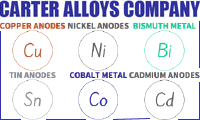
Curated with aloha by
Ted Mooney, P.E. RET

The authoritative public forum
for Metal Finishing 1989-2025

-----
TIN WHISKER PROBLEM
I'M A CADET PROCESS ENGINEER HERE IN THE PHILIPPINES AND I HANDLE TIN PLATING.THE BIGGEST PROBLEM SO FAR IS THE OCCURRENCE OF WHISKER AND IT AFFECT A QUITE LARGE NUMBER OF QUANTITY.I KNOW THAT SUCH PROBLEM IS COMMON IN TIN PLATING. I JUST WONDER IF THERE IS A WAY TO CONTROL IT OR TO AT LEAST MINIMIZED IT. THANKS. AIMEE
AIMEE MAGNO- PHILIPPINES
1999
Aimee, There is a lot of info of this on the net. A good place to start is a web site at NASA by a Jay Brusse. http://misspiggy.gsfc.nasa.gov/whisker
Clinton Hilliard- Columbia, Maryland
1999
1999
The chief cause of whisker growth is the presence of stresses in the tin coating. Some methods to reduce are,
- *flow brightening or annealing the tin plate to reduce the internal stresses.
- *Plating tin to sufficient thickness to minimize stress producing epitaxial effects.
- *Use of compatible underplatings, especially nickel.
- *Alloy plating, such as lead, bismuth, antimony, copper or nickel.
Tin/lead is the most widely used alloy plate to prevent whisker growth, but it does deposit about 7% lead with the remainder tin which has limits with contact to food. The most common fix is to underplate with nickel to about .0002. The underplate is actually beneficial in soldering operations while also reducing zinc migration of brass and copper alloys. Good luck
Tim Martinplating shop - Springfield, Massachusetts
adv.: Supplier of Copper Anodes, Nickel Anodes, Bismuth Metal, & Other Metal Products for Industry & The Arts

Q, A, or Comment on THIS thread -or- Start a NEW Thread